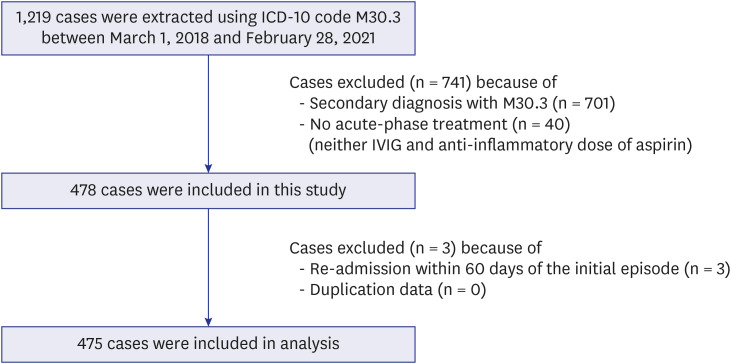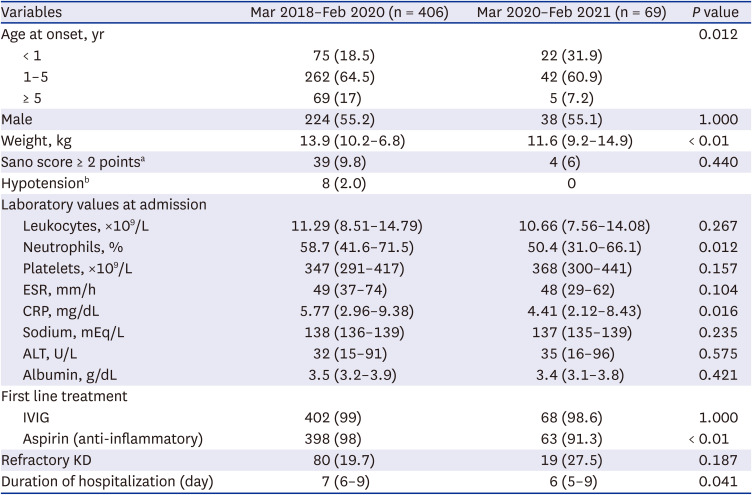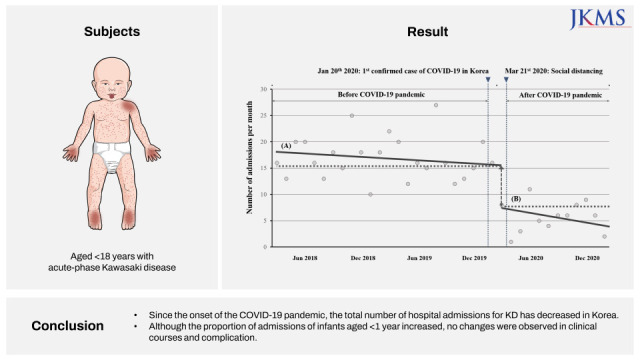1. McCrindle BW, Rowley AH, Newburger JW, Burns JC, Bolger AF, Gewitz M, et al. Diagnosis, treatment, and long-term management of Kawasaki disease: a scientific statement for health professionals from the American Heart Association. Circulation. 2017; 135(17):e927–e999. PMID:
28356445.
2. Singh S, Vignesh P, Burgner D. The epidemiology of Kawasaki disease: a global update. Arch Dis Child. 2015; 100(11):1084–1088. PMID:
26111818.
3. Kim GB, Eun LY, Han JW, Kim SH, Yoon KL, Han MY, et al. Epidemiology of Kawasaki disease in South Korea: a nationwide survey 2015-2017. Pediatr Infect Dis J. 2020; 39(11):1012–1016. PMID:
33075217.
4. Rife E, Gedalia A. Kawasaki disease: an update. Curr Rheumatol Rep. 2020; 22(10):75. PMID:
32924089.
5. Cucinotta D, Vanelli M. WHO declares COVID-19 a pandemic. Acta Biomed. 2020; 91(1):157–160. PMID:
32191675.
6. Ministry of Health and Welfare. Coronavirus disease-19, Republic of Korea. Updated 2021. Accessed August 1, 2021.
http://ncov.mohw.go.kr/en
.
7. Park IN, Yum HK. Stepwise strategy of social distancing in Korea. J Korean Med Sci. 2020; 35(28):e264. PMID:
32686376.
9. Kuitunen I, Artama M, Mäkelä L, Backman K, Heiskanen-Kosma T, Renko M. Effect of social distancing due to the COVID-19 pandemic on the incidence of viral respiratory tract infections in children in Finland during early 2020. Pediatr Infect Dis J. 2020; 39(12):e423–e427. PMID:
32773660.
10. Goldman RD, Grafstein E, Barclay N, Irvine MA, Portales-Casamar E. Paediatric patients seen in 18 emergency departments during the COVID-19 pandemic. Emerg Med J. 2020; 37(12):773–777. PMID:
33127743.
11. Lin CF, Huang YH, Cheng CY, Wu KH, Tang KS, Chiu IM. Public health interventions for the COVID-19 pandemic reduce respiratory tract infection-related visits at pediatric emergency departments in Taiwan. Front Public Health. 2020; 8:604089. PMID:
33392141.
12. Choi DH, Jung JY, Suh D, Choi JY, Lee SU, Choi YJ, et al. Impact of the COVID-19 outbreak on trends in emergency department utilization in children: a multicenter retrospective observational study in Seoul metropolitan area, Korea. J Korean Med Sci. 2021; 36(5):e44. PMID:
33527786.
14. Hirata S, Nakamura Y, Yanagawa H. Incidence rate of recurrent Kawasaki disease and related risk factors: from the results of nationwide surveys of Kawasaki disease in Japan. Acta Paediatr. 2001; 90(1):40–44. PMID:
11227331.
15. Wagner AK, Soumerai SB, Zhang F, Ross-Degnan D. Segmented regression analysis of interrupted time series studies in medication use research. J Clin Pharm Ther. 2002; 27(4):299–309. PMID:
12174032.
16. Sano T, Kurotobi S, Matsuzaki K, Yamamoto T, Maki I, Miki K, et al. Prediction of non-responsiveness to standard high-dose gamma-globulin therapy in patients with acute Kawasaki disease before starting initial treatment. Eur J Pediatr. 2007; 166(2):131–137. PMID:
16896641.
17. Kleinman ME, Chameides L, Schexnayder SM, Samson RA, Hazinski MF, Atkins DL, et al. Part 14: pediatric advanced life support: 2010 American Heart Association guidelines for cardiopulmonary resuscitation and emergency cardiovascular care. Circulation. 2010; 122(18):Suppl 3. S876–S908. PMID:
20956230.
18. Kang JM, Kim YE, Huh K, Hong J, Kim DW, Kim MY, et al. Reduction in Kawasaki Disease after nonpharmaceutical interventions in the COVID-19 era: a nationwide observational study in Korea. Circulation. 2021; 143(25):2508–2510. PMID:
34092115.
19. Kim M, Chae KH, Chung YJ, Hwang H, Lee M, Kim HK, et al. The effect of the look-back period for estimating incidence using administrative data. BMC Health Serv Res. 2020; 20(1):166. PMID:
32131818.
20. Ristevski B, Chen M. Big data analytics in medicine and healthcare. J Integr Bioinform. 2018; 15(3):20170030.
21. Hara T, Furuno K, Yamamura K, Kishimoto J, Mizuno Y, Murata K, et al. Assessment of pediatric admissions for Kawasaki disease or infectious disease during the COVID-19 state of emergency in Japan. JAMA Netw Open. 2021; 4(4):e214475. PMID:
33822065.
22. Iio K, Matsubara K, Miyakoshi C, Ota K, Yamaoka R, Eguchi J, et al. Incidence of Kawasaki disease before and during the COVID-19 pandemic: a retrospective cohort study in Japan. BMJ Paediatr Open. 2021; 5(1):e001034.
23. Ae R, Shibata Y, Kosami K, Nakamura Y, Hamada H. Kawasaki disease and pediatric infectious diseases during the coronavirus disease 2019 pandemic. J Pediatr. 2021; 239:50–58.e2. PMID:
34324881.
24. Kim JH, Roh YH, Ahn JG, Kim MY, Huh K, Jung J, et al. Respiratory syncytial virus and influenza epidemics disappearance in Korea during the 2020-2021 season of COVID-19. Int J Infect Dis. 2021; 110:29–35. PMID:
34245886.
25. Choi A, Bae W, Kim K, Kim S. Impact of Covid-19 on the visit of pediatric patients with injuries to the emergency department in Korea. Children (Basel). 2021; 8(7):568. PMID:
34356547.
26. Davis AL, Sunderji A, Marneni SR, Seiler M, Hall JE, Cotanda CP, et al. Caregiver-reported delay in presentation to pediatric emergency departments for fear of contracting COVID-19: a multi-national cross-sectional study. CJEM. 2021; 23(6):778–786. PMID:
34402036.
27. Ciacchini B, Tonioli F, Marciano C, Faticato MG, Borali E, Pini Prato A, et al. Reluctance to seek pediatric care during the COVID-19 pandemic and the risks of delayed diagnosis. Ital J Pediatr. 2020; 46(1):87. PMID:
32600464.
28. Lazzerini M, Barbi E, Apicella A, Marchetti F, Cardinale F, Trobia G. Delayed access or provision of care in Italy resulting from fear of COVID-19. Lancet Child Adolesc Health. 2020; 4(5):e10–e11. PMID:
32278365.
29. Shulman S, Geevarghese B, Kim KY, Rowley A. The impact of social distancing for COVID-19 upon diagnosis of Kawasaki disease. J Pediatric Infect Dis Soc. 2021; 10(6):742–744. PMID:
33755140.
30. Do YS, Kim KW, Chun JK, Cha BH, Namgoong MK, Lee HY. Predicting factors for refractory Kawasaki disease. Korean Circ J. 2010; 40(5):239–242. PMID:
20514335.
31. Okada S, Hasegawa S, Suzuki Y, Matsubara T, Shimomura M, Okuda M, et al. Acute pericardial effusion representing the TNF-α-mediated severe inflammation but not the coronary artery outcome of Kawasaki disease. Scand J Rheumatol. 2015; 44(3):247–252. PMID:
25351965.
32. Verdoni L, Mazza A, Gervasoni A, Martelli L, Ruggeri M, Ciuffreda M, et al. An outbreak of severe Kawasaki-like disease at the Italian epicentre of the SARS-CoV-2 epidemic: an observational cohort study. Lancet. 2020; 395(10239):1771–1778. PMID:
32410760.
33. Feldstein LR, Rose EB, Horwitz SM, Collins JP, Newhams MM, Son MBF, et al. Multisystem inflammatory syndrome in U.S. children and adolescents. N Engl J Med. 2020; 383(4):334–346. PMID:
32598831.
34. Ebina-Shibuya R, Namkoong H, Shibuya Y, Horita N. Multisystem inflammatory syndrome in children (MIS-C) with COVID-19: insights from simultaneous familial Kawasaki Disease cases. Int J Infect Dis. 2020; 97:371–373. PMID:
32553716.
35. Fukuda S, Kaneta M, Miyake M, Ohya T, Miyakawa K, Iwamoto M, et al. A case of multisystem inflammatory syndrome in children in a Japanese boy: with discussion of cytokine profile. Mod Rheumatol Case Rep. 2021; 5(2):442–447. PMID:
33904379.
36. Choe YJ, Choi EH, Choi JW, Eun BW, Eun LY, Kim YJ, et al. Surveillance of COVID-19-associated multisystem inflammatory syndrome in children, South Korea. Emerg Infect Dis. 2021; 27(4):1196–1200. PMID:
33539720.
37. Iio K, Uda K, Hataya H, Yasui F, Honda T, Sanada T, et al. Kawasaki disease or Kawasaki-like disease: influence of SARS-CoV-2 infections in Japan. Acta Paediatr. 2021; 110(2):600–601. PMID:
32799392.
38. Kim YJ, Park H, Choi YY, Kim YK, Yoon Y, Kim KR, et al. Defining association between COVID-19 and the multisystem inflammatory syndrome in children through the pandemic. J Korean Med Sci. 2020; 35(22):e204. PMID:
32508068.









 PDF
PDF Citation
Citation Print
Print




 XML Download
XML Download